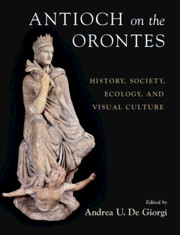Book contents
- Antioch on the Orontes
- Antioch on the Orontes
- Copyright page
- Dedication
- Contents
- Plates
- Figures
- Tables
- Contributors
- Abbreviations
- Antioch on the Orontes
- Part I Beginnings
- Part II The Making of a Capital
- Part III The People of Antioch
- Part IV Religion
- Part V Crises and Resilience
- Chapter 27 Earthquakes and State Response at Antioch
- Chapter 28 Disasters and Divine Wrath
- Chapter 29 Infectious Disease and Its Repercussions in Sixth-Century Antioch
- Chapter 30 Memory and the City
- Index
- Plate Section
- References
Chapter 27 - Earthquakes and State Response at Antioch
Hellenistic to Early Byzantine
from Part V - Crises and Resilience
Published online by Cambridge University Press: aN Invalid Date NaN
- Antioch on the Orontes
- Antioch on the Orontes
- Copyright page
- Dedication
- Contents
- Plates
- Figures
- Tables
- Contributors
- Abbreviations
- Antioch on the Orontes
- Part I Beginnings
- Part II The Making of a Capital
- Part III The People of Antioch
- Part IV Religion
- Part V Crises and Resilience
- Chapter 27 Earthquakes and State Response at Antioch
- Chapter 28 Disasters and Divine Wrath
- Chapter 29 Infectious Disease and Its Repercussions in Sixth-Century Antioch
- Chapter 30 Memory and the City
- Index
- Plate Section
- References
Summary
This chapter considers the nature of state aid and intervention after earthquakes at Antioch between the Hellenistic period and Late Antiquity.
Keywords
- Type
- Chapter
- Information
- Antioch on the OrontesHistory, Society, Ecology, and Visual Culture, pp. 433 - 450Publisher: Cambridge University PressPrint publication year: 2024



